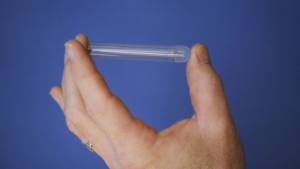New sex option for men
The medical industry’s investment in the multibillion-dollar female birth control industry might block men’s access to male birth control just as effectively as Vasalgel would block their sperm. – Samantha Allen, Ph.D.

(Parsemus 2016)
Prior to this new technology, the vasectomy offered the most reliable form of male contraception, but even this procedure has negative consequences associated with it (Sher 2010). Although very rare, concerns with the vasectomy include the possibility of pressure build up in the vas deferens as well as the formation of sperm granulomas (Parsemus Foundation 2016). The vas deferens is the tube that carries sperm from inside the body to the outside, and sperm granulomas are simply lumps of sperm. These granulomas develop in men with vasectomies when sperm comes into contact with surrounding tissue (Parsemus Foundation 2016). The most important consideration for a male considering a vasectomy is that the procedure is permanent; it makes an irreversible cut to the vas deferens (Vasalgel 2016).
But now, let us explore the newest male contraceptive technology: Vasalgel™.
“Everyone should know this stuff” Level
Vasalgel™ is not a plug, but a non-hormonal polymer gel injection that is injected into the vas deferens of the male (Vasalgel 2016). This gel, with its semi-permeable membrane, allows seminal fluids to pass – excluding the sperm cells, which are too large to pass through (Parsemus Foundation 2016). The sperm is later reabsorbed into the body (Parsemus Foundation 2016). This eliminates the issues of pressure build up and granuloma development in the vas deferens that are often experienced in men with vasectomies (Parsemus Foundation 2016). Unlike the vasectomy, Vasalgel™ can be reversed with a baking soda injection if the male desires (Vasalgel 2016). It is a one time procedure that is projected to cost less than $800, and interestingly, this is less expensive than most IUDs for women (Millikan 2015).
The only requirement after surgery is that the male waits for as little as a month to have unprotected sex; otherwise, he could risk an unplanned pregnancy (Castillo 2015). The procedure itself is minimally invasive; it requires only a small incision into the scrotal skin, and altogether the surgery takes about 10-15 minutes (Castillo 2015). The patient can then leave within minutes of the surgery’s completion (Castillo 2015). Neither ejaculation or orgasm are affected by the injection of the gel (Parsemus Foundation 2016).
To date, there are no apparent side effects associated with Vasalgel™ (Castillo 2015). Although Vasalgel™ is only just entering clinical trials, there have been studies proving its success rates. Recently, a trial study of Vasalgel™ was completed on three male baboons (Allen 2014). After being injected with the gel, each baboon was given access to 10 to 15 female baboons, and after a six month period of monkeying around, not a single female was impregnated (Allen 2014).
The biggest issue with the procedure is that the long term effects are not well studied. There have been some recorded cellular changes, such as epithelial degeneration in the seminiferous tubules of the testes (Mishra 2016). The seminiferous tubules are where the sperm is created (Mishra 2016). However, in the baboon study mentioned above, within 150 days of reversing the procedure, these cellular changes returned to normal (Vasalgel 2016). This means that due to epithelial degeneration, immediately after removal of Vasalgel™, the seminiferous tubules were not able to produce normal sperm for about 150 days (Vasalgel 2016). Then, sperm production returned to normal.
Other than this uncertainty, there are very few negatives to the gel. The hardest part about this new technology is finding investors. Because Vasalgel™ is a long term treatment, it is far more lucrative for an investor to buy into a product like birth control pills, which must regularly be purchased (Allen 2014). Samantha Allen, who holds a Ph.D. in Women’s gender and sexuality studies, stated: “The medical industry’s investment in the multibillion-dollar female birth control industry might block men’s access to male birth control just as effectively as Vasalgel would block their sperm” (Allen 2014).
So why is Vasalgel™ the key to stopping unplanned pregnancy? Vasalgel™ does not interfere with male hormones or sperm production (Allen 2014). This is in contrast to many female contraceptives – like birth control – which alter hormone levels and the ovulation cycle itself. This manipulation of hormone levels is not healthy for the 62 percent of all reproductive women who use a contraceptive method, and these medications have many adverse side effects for women (Guttmacher 2015). Male contraceptives are simply the solution.
“For geniuses only” Level
Vasalgel™ is not the first attempt at this type of male contraception. 15 years ago, Suhjoy Guha, a professor of Biomedical Engineering at IIT Kharagpur, created a new form of male contraceptive called RISUG (Allen 2014). RISUG, which stands for Reversible Inhibition of Sperm Under Guidance, although effective, has only been made available to men in and nearby India (Allen 2014). Despite being used by men for more than 15 years, it is still technically only in the clinical trial stage in India (Allen 2014). RISUG is made up of a combination of dimethyl sulfoxide (DMSO) and styrene maleic anhydride (SMA) (Vasalgel 2016). RISUG is a polyelectrolyte, and as the name suggests, it is similar to both polymers (poly) and salts (electrolyte) (Thakur 2013). The mechanism of action of RISUG is sperm destruction. When RISUG comes into contact with sperm, the membranes of the sperm experience an ionic imbalance; this simply means a difference in charges between the sperm and RISUG (Thakur 2013). This imbalance causes the head of the sperm to rupture, therefore releasing the ova fertilizing enzymes – Hyaluronidase and Acrosin – into the vas deferens (Thakur 2013).
Impress your friends and family with these three related facts:
Fact 1: 16 percent of males ages 36-45 have had a vasectomy (Guttmacher 2016).
Fact 2: The male condom is the most commonly used form of contraception among both men and women (Guttmacher 2016).
Fact 3: There is an 85% chance that a couple that does not use any form of contraception will become pregnant over the course of one year (Guttmacher 2016).
Author: This page was created by Zoë Stublarec, a senior at Choate Rosemary Hall in Wallingford, CT. Zoë’s spirit animal is a chinchilla. Someday, Zoë will be famous for owning and operating an underground “Betta Fish Fight Club.”

Works Cited
Allen, Samantha. The Daily Beast. Newsweek/Daily Beast. 9 Sep. 2014. Accessed on: 31 Jan. 2016. http://www.thedailybeast.com/articles/2014/09/09/we-ll-have-male-birth-control-by-2017.html
Castillo, Stephanie. “Everything You Need to Know About Male Birth Control.” Medical Daily. 15 July. 2015. Accessed on: 31 Jan. 2016. http://www.medicaldaily.com/male-birth-control-vasalgel-closer-becoming-reality-heres-everything-we-know-so-far-343032
“Distinguish Alumnus Awardee.” Distinguish Alumnus Awardee. Accessed on: 16 Feb. 2016. http://www.iitkgp.ac.in/top-awardees/daa1.php?Sl=73
Guttamacher Institute. “Contraceptive Use in the United States.” Contraceptive Use in the United States. October 2015. Accessed on: 16 Feb. 2016. http://www.guttmacher.org/pubs/fb_contr_use.html
Millikan, Arikia. “The Perfect Birth Control for Men Is Here. Why Can’t We Use It?” Motherboard. 1 April 2015. Accessed on: 18 Feb. 2016. http://motherboard.vice.com/read/the-perfect-birth-control-for-men-is-here-why-cant- we-use-it
Mishra, PK. “Status of spermatogenesis and sperm parameters in langur monkeys following long-term vas occlusion with styrene maleic anhydride.” National Center for Biotechnology Information. U.S. National Library of Medicine. Accessed on: 18 Feb. 2016. http://www.ncbi.nlm.nih.gov/pubmed/12826690
Mueller, 2012. http://www.henrymakow.com/contraception_and_the_female_p.html
Parsemus Foundation. “Vasalgel FAQ’s -.” Parsemus Foundation. Accessed on: 22 Feb. 2016. http://www.parsemusfoundation.org/projects/vasalgel/vasalgel-faqs/ .
Sher, Lauren. “Medical Mystery Behind Women’s Surprise Birth.” ABC News. ABC News Network. Accessed on: 16 Feb. 2016. http://abcnews.go.com/2020/vasectomycomplications-womans-surprise-pregnancy/story?id=9561100
Thakur, Vikas. “RISUG.” Asian Pacific Journal of Reproduction. Asian Pacific Journal of Reproduction Editorial Office. 22 March 2013. Accessed on: 18 Feb. 2016. http://www.apjr.net/Issues/201302/PDF/15.PDF.pdf

Leave a Reply